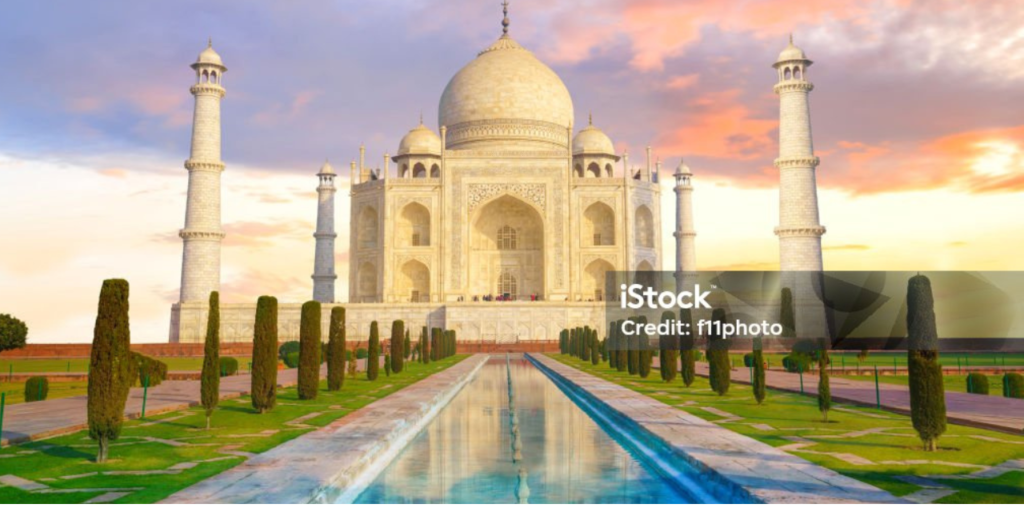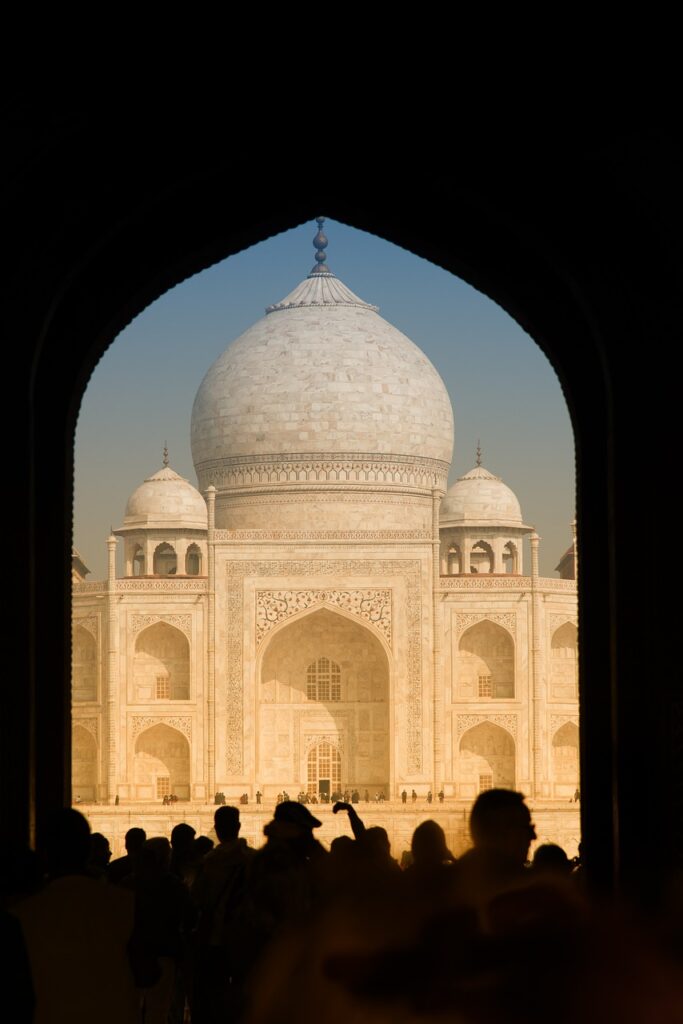“Taj Mahal: Icon of Love and Legacy” [1648]

The Taj Mahal is a beautiful white marble mausoleum located in Agra, India. It was built by the Mughal emperor Shah Jahan in memory of his beloved wife Mumtaz Mahal. Completed in 1653, it is renowned for its stunning architecture and intricate carvings. The Taj Mahal is considered one of the most iconic symbols of love and is a UNESCO World Heritage Site visited by millions of people from around the world every year.
Table of Contents
History Behind the Taj Mahal ?
- The Taj Mahal was built by a Mughal emperor named Shah Jahan.
- He built it in memory of his wife Mumtaz Mahal.
- Mumtaz Mahal died while giving birth to their 14th child.
- Construction started in 1632 and took about 21 years to finish.
- Thousands of workers and artisans worked on it.
- It’s made of white marble and has beautiful gardens around it.
- The Taj Mahal is famous for its symmetrical design and intricate carvings.
- It’s a symbol of love and considered one of the wonders of the world.
- People from all over the world visit the Taj Mahal every year.
- It’s located in the city of Agra, in the northern part of India.
Secrets Behinds the Taj Mahal?
- The Taj Mahal changes color with the light, appearing pinkish in the morning, milky white in the evening, and golden under moonlight.
- There are symmetrical gardens in front of the Taj Mahal that represent paradise.
- Inside, there are precious gemstones and intricate designs embedded in the marble walls.
- The Taj Mahal is designed so that the minarets surrounding it tilt slightly outward, to protect the main building in case of an earthquake.
- The location of the tomb is not exactly at the center of the Taj Mahal; it is placed slightly towards the west to achieve perfect symmetry in its appearance.

Where is Taj Mahal Located?
The Taj Mahal is located in the city of Agra, in the northern state of Uttar Pradesh, India. It stands on the southern bank of the Yamuna River, surrounded by gardens and other Mughal-era structures. Built by Emperor Shah Jahan in the 17th century, it is a symbol of his love for his wife Mumtaz Mahal, whose tomb it houses. The Taj Mahal is renowned for its exquisite white marble architecture, adorned with intricate carvings and precious gemstones. Recognized as a UNESCO World Heritage Site, it attracts millions of tourists annually, fascinated by its beauty and historical significance.
Some Facts About the Taj Mahal?
- The Taj Mahal was built by a king named Shah Jahan.
- He built it for his wife Mumtaz Mahal who died.
- Construction took about 22 years.
- It’s made of white marble from Rajasthan.
- The building is perfectly symmetrical.
- There are beautiful gardens around it.
- Inside, there are intricate designs and carvings.
- The Taj Mahal changes color with the sunlight.
- It’s a UNESCO World Heritage Site.
- Many people visit it every year.
Architecture Of the Taj Mahal?
The Taj Mahal is a big white building with a dome on top. It has four tall pillars called minarets at each corner. The main part of the building is made of marble, and there are lots of beautiful designs carved into the walls. Inside, there’s a big hall with arches and a special room where the emperor’s wife is buried. The gardens around the Taj Mahal are very pretty, with pathways and trees. The whole place looks very symmetrical, which means everything is balanced and looks the same on both sides. Many people think it’s one of the most beautiful buildings in the world.
The Taj Mahal was built by the Mughal emperor Shah Jahan as a monument to his beloved wife Mumtaz Mahal, who passed away during childbirth. Construction began in 1632 and took around 22 years to complete, involving thousands of artisans, craftsmen, and laborers. Shah Jahan commissioned the best architects, engineers, and designers from across the empire and beyond to create a masterpiece of Mughal architecture. The design blends elements from Islamic, Persian, Ottoman Turkish, and Indian architectural styles, showcasing intricate carvings, delicate marble inlay work, and symmetrical layouts. The Taj Mahal’s exquisite beauty and craftsmanship have made it a symbol of eternal love and a UNESCO World Heritage site.
FAQ’s
What is the Taj Mahal?
The Taj Mahal is a famous monument located in Agra, India, known for its stunning white marble architecture.
Who built the Taj Mahal?
The Taj Mahal was built by the Mughal Emperor Shah Jahan in memory of his wife Mumtaz Mahal.
When was the Taj Mahal built?
Construction of the Taj Mahal started in 1632 and was completed in 1653.
Why was the Taj Mahal built?
Shah Jahan built the Taj Mahal as a mausoleum for his wife Mumtaz Mahal, who passed away during childbirth.
What materials were used to build the Taj Mahal?
The Taj Mahal is primarily made of white marble from Rajasthan, India. It also incorporates precious gemstones and intricate carvings.
What is special about the architecture of the Taj Mahal?
The Taj Mahal is renowned for its symmetrical layout, exquisite marble inlay work, and the perfect balance of design elements from Islamic, Persian, Ottoman Turkish, and Indian architectural styles.
Is the Taj Mahal a UNESCO World Heritage site?
Yes, the Taj Mahal has been designated as a UNESCO World Heritage site since 1983.
How many visitors does the Taj Mahal receive annually?
The Taj Mahal attracts millions of visitors from around the world every year, making it one of the most visited monuments globally.
What is the significance of the Taj Mahal?
The Taj Mahal is considered a symbol of love and is regarded as one of the most iconic landmarks in the world, representing the architectural and cultural heritage of India.
Can visitors enter the Taj Mahal?
Yes, visitors can enter the Taj Mahal to explore its interior, gardens, and admire its architecture.
Conclusion
Taj Mahal is a breathtaking symbol of love and beauty. Built by Emperor Shah Jahan for his beloved wife Mumtaz Mahal, it stands as a masterpiece of architecture and craftsmanship. The white marble monument with its intricate designs and symmetrical gardens continues to captivate millions of visitors each year. Recognized as a UNESCO World Heritage site, the Taj Mahal holds immense cultural and historical significance, reflecting India’s rich heritage. It serves as a poignant reminder of eternal love and remains one of the most cherished and iconic landmarks in the world.






